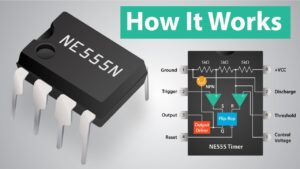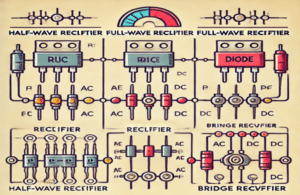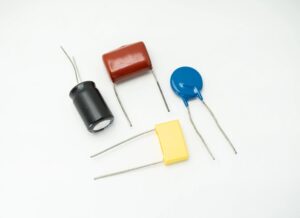From the smartphone you use to connect with loved ones to the refrigerator that preserves your food, Electrical Components like bridge rectifiers are omnipresent, quietly ensuring the smooth operation of myriad electronic devices.
But what exactly is a bridge rectifier? Why is it crucial in electronics? And what are the different types of rectifiers? This is exactly what we will explore here. We will take a detailed look at 4 types of rectifiers, each with its working principles and advantages.
Additionally, we’ll touch on the types of capacitors and types of resistors that play vital roles in various electronic circuits.
What Are Bridge Rectifiers?
At its core, a bridge rectifier is a type of electrical circuit designed to convert alternating current (AC), which periodically reverses direction, into direct current (DC), which flows consistently in a single direction. This conversion ensures that the electronic devices we depend on daily receive a steady, unidirectional flow of electricity, enabling them to operate smoothly and reliably.
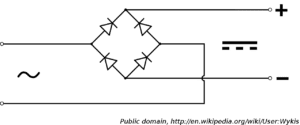
The Importance of Bridge Rectifiers in Electronic Circuits
There are different types of bridge rectifiers in all aspects of our daily lives, powering and stabilizing various electronic devices and gadgets we often take for granted. From charging your smartphone and powering your computer to keeping your refrigerator running, bridge rectifiers work tirelessly behind the scenes, ensuring that these devices receive the type of current they need to function effectively. In essence, they act as gatekeepers, directing the flow of electricity and ensuring stability in our electronic circuits.
4 Types of Bridge Rectifiers
There is more than one way to classify the types of bridge rectifiers but the most common types of bridge rectifiers are as follows:
- Single-Phase Rectifier
- Three-Phase Rectifier
- Controlled Rectifier
- Diode Bridge Rectifier
In the following sections, we will consider each of these individually and consider their working principles and advantages.
Table of Comparing Different Types of Rectifiers
Understanding the differences and applications of each type is pivotal in selecting the right rectifier for your specific needs and applications. Let’s delve into a comparative analysis, exploring the usage and characteristics of each type, to provide a comprehensive perspective that will guide your selection in your electronic endeavors.
| Type of Rectifier | Usage/Applications | Characteristics | Power Handling Capability | DC Output Smoothness | Design Complexity | Cost Implication |
| Single-Phase Rectifier | Battery charging, radio power supplies, small electronic devices | Simple design, cost-effective, suitable for low-power applications | Low to Moderate | Moderate Ripples | Low | Low to Moderate |
| Three-Phase Rectifier | Electric motor drives, industrial machinery, high-power applications | Handles higher power, smoother DC output, requires three-phase AC input | High | Smooth | High | Moderate to High |
| Controlled Rectifier | Variable speed drives, adjustable lighting systems, precise power supply designs | Precise control over output voltage, adaptable, complex design | Variable | Highly Smooth | Very High | High |
| Diode Bridge Rectifier | Household adapters, general power supplies in electronic appliances | Simple, reliable, cost-effective, may require additional filtering | Low to Moderate | Moderate Ripples | Low | Low |
1. Single-Phase Bridge Rectifiers
A single-phase bridge rectifier is designed to manage a single-phase AC input, converting it into a steady DC output. This type of rectifier is commonly found in various everyday electronic devices, such as battery chargers, power supplies for radios, and even your computer’s power supply, silently ensuring that they receive a stable, consistent supply of DC.
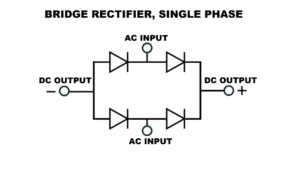
Working Principle of Single-Phase Bridge Rectifiers
The single-phase bridge rectifier takes on a similar challenge with electrical current. Comprising four diodes arranged in a bridge configuration, this rectifier takes the AC, which flows back and forth, and cleverly utilizes the diodes to ensure that the output current always flows in one direction, producing a DC. During each half cycle of the AC, two diodes conduct, allowing current to flow in the desired direction, while the other two block any reverse flow, ensuring a unidirectional output.
Advantages and Limitations of Single-Phase Bridge Rectifiers
The single-phase bridge rectifier comes with its set of advantages and limitations that make it suitable for specific applications. On the one hand, its simplicity, reliability, and ease of design make it a popular choice for low-to-moderate power applications. It’s a component that doesn’t complicate matters, providing a straightforward solution to converting AC to DC.
However, on the flip side, single-phase bridge rectifiers are not without their limitations. They may not be the best fit for high-power applications due to their inability to handle high voltage and current efficiently. Moreover, they produce a DC output that, while steady, isn’t as smooth as one might desire for more sensitive applications, often requiring additional filtering to smooth out the ripples in the DC output.
2. Three-Phase Bridge Rectifiers
Unlike its single-phase counterpart, the three-phase bridge rectifier is designed to manage a three-phase AC input, making it a stalwart in industrial applications where higher power conversion is paramount. From electric motors driving heavy machinery to large-scale power supplies, the three-phase bridge rectifier silently underpins numerous industrial and high-power applications, ensuring a steady conversion from AC to DC.
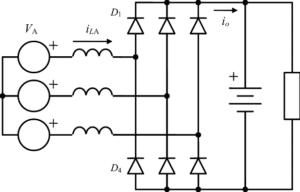
Working Principle of Three-Phase Bridge Rectifiers
Picture a bustling three-lane highway, where each lane represents a phase of AC, each with its own ebb and flow of electrical current. The three-phase bridge rectifier, equipped with six diodes arranged in a specific configuration, manages these three lanes (phases) of AC. It skillfully directs the currents, ensuring that the output is a consistent, unidirectional DC, despite the alternating nature of the input from each phase. By doing so, it provides a DC output that is smoother and more stable than that of a single-phase rectifier, adeptly handling the complexities of three-phase AC.
Advantages and Limitations of Three-Phase Bridge Rectifiers
The three-phase bridge rectifier shines in its ability to provide a smoother DC output and manage higher power levels, making it a preferred choice for industrial and high-power applications. Its capability to handle three-phase AC allows it to deliver a DC with fewer ripples, often negating the need for extensive filtering and providing a more stable power supply for larger machinery and systems.
However, it’s essential to acknowledge that the three-phase bridge rectifier comes with its own set of challenges. Its complexity in terms of design and implementation, coupled with the necessity for three-phase AC input, can make it an overkill for smaller, low-power applications. Additionally, the requirement for six diodes (as opposed to four in single-phase rectifiers) can also introduce additional considerations in terms of cost and design complexity.
3. Controlled Bridge Rectifiers
Unlike its uncontrolled counterparts, the controlled bridge rectifier employs controlled semiconductor devices (such as thyristors or IGBTs) instead of diodes, enabling it to regulate the timing and magnitude of the output DC. This meticulous control finds its applications in various domains, such as variable speed drive motors, adjustable lighting systems, and power supply designs, where precise control over the output voltage is crucial.
Working Principle of Controlled Bridge Rectifiers
By controlling the firing angle of the semiconductor devices, it can manipulate when and how much of the input AC is allowed to pass through to the output, thereby regulating the DC. This ability to control not only the direction but also the magnitude of the output current allows for a tailored electrical output, adaptable to specific needs and applications.
Advantages and Limitations of Controlled Bridge Rectifiers
The controlled bridge rectifier boasts the advantage of providing precise control over the output voltage, enabling it to adapt to varying power requirements and ensuring optimal performance in applications where control is paramount. Its ability to modulate the output makes it a versatile component, capable of catering to a myriad of applications that demand more than just a steady DC.
However, it’s imperative to acknowledge that with the added control comes added complexity. The design and implementation of controlled bridge rectifiers are more complex because of the need to accurately control the semiconductor devices. Also, these types of bridge rectifiers require supplementary circuits and components to manage the firing angles and ensure stable, reliable operation, which can introduce additional considerations in terms of cost, design, and maintenance.
4. Simple Diode Bridge Rectifiers
Diode bridge rectifiers, sometimes referred to simply as bridge rectifiers, utilize diodes (uncontrolled semiconductor devices that allow current to flow in one direction only) to convert alternating current (AC) into direct current (DC). This type of rectifier is a staple in numerous electronic devices, from your household adapters that charge your devices to power supplies in various electronic appliances, ensuring a consistent and steady DC output.
Working Principle of Simple Diode Bridge Rectifiers
The most common one among types of bridge rectifiers, the diode rectifier operates on a similar principle, utilizing four diodes arranged in a “bridge” configuration. As the AC flows into the rectifier, the diodes allow current to flow in only one direction, thereby converting the oscillating AC into a pulsating DC. The simplicity and effectiveness of this mechanism have made diode bridge rectifiers a popular choice for a myriad of applications where a stable DC is required.
Advantages and Limitations of Simple Diode Bridge Rectifiers
Diode bridge rectifiers come with a suite of advantages that have cemented their place in electronic design. Their simplicity, reliability, and cost-effectiveness make them an attractive choice for a wide range of applications, providing a straightforward solution for AC to DC conversion without the need for complex control mechanisms or additional components.
However, it’s pivotal to recognize that diode bridge rectifiers are not without limitations. The DC output, while steady, is not smooth and often requires additional filtering to eliminate ripples for applications that require a smoother DC. Furthermore, diode bridge rectifiers are not suitable for applications that require control over the output voltage or applications that demand high-efficiency conversion, especially at high power levels.
Navigating Through Choices
- Single-Phase Rectifier: A straightforward, cost-effective solution for applications that do not require high power or a smooth DC output. Ideal for hobbyist projects and small-scale electronic devices.
- Three-Phase Rectifier: A robust choice for industrial applications where high power and a smoother DC output are paramount. However, the complexity and need for three-phase AC input can be limiting in some scenarios.
- Controlled Rectifier: The go-to option for applications that demand precise control over the output voltage. The complexity and additional components required make it suitable for specific, controlled applications.
- Diode Bridge Rectifier: A universal, reliable option for a myriad of general applications. Its simplicity and reliability make it a popular choice, albeit with the caveat of a not-so-smooth DC output.
Making Informed Decisions
Understanding the unique attributes and applications of the different types of bridge rectifier enables you to make informed decisions, ensuring that your projects and applications are powered efficiently and effectively. Whether you’re designing a simple power supply for a small electronic device or engineering a complex industrial power system, having a comprehensive understanding of the available options empowers you to navigate through the electronic landscape with confidence and expertise. If you enjoyed this guide on the 4 types of bridge rectifiers, make sure to check out our post on the different types of amplifiers as well.
FAQ about Types Of Bridge Rectifiers
- What is a Bridge Rectifier?
A bridge rectifier is an electrical circuit that converts alternating current (AC) to direct current (DC), ensuring a unidirectional flow of electricity for various electronic applications.
- Why is Understanding Different Types of Bridge Rectifiers Important?
Different types of bridge rectifiers cater to varied power needs, and applications, and provide distinct advantages and limitations. Understanding them helps in choosing the right component for specific electronic requirements.
- Where are Single-Phase Rectifiers usually used?
Single-phase rectifiers are commonly used in low-to-moderate power applications like battery charging, radio power supplies, and small electronic devices due to their simplicity and cost-effectiveness.
- How Does a Three-Phase Rectifier Differ from a Single-Phase Rectifier?
Three-phase rectifiers can handle higher power levels and provide a smoother DC output, making them suitable for industrial and high-power applications, whereas single-phase rectifiers are used for lower power needs.
- What is the reason for using Controlled Bridge Rectifiers?
Controlled bridge rectifiers allow precise control over the output voltage, making them suitable for applications that demand specific voltage requirements and adaptability, such as variable speed drives and adjustable lighting systems.
- Are Diode Bridge Rectifiers Suitable for High-Power Applications?
Diode bridge rectifiers are versatile and widely used but may not be the best fit for high-power applications due to their limitations in handling high voltage and providing a smooth DC output without additional filtering.
- How Do I Choose the Right Type of Rectifier for My Project?
Consider the power requirements, desired DC output smoothness, design complexity, and specific application needs of your project. Refer to Section 5 of the blog post for a comparative analysis to guide your selection.
- Can I Use a Three-Phase Rectifier for Household Applications?
While possible, three-phase rectifiers are typically more complex and may be overkill for household applications, which are often sufficiently managed by single-phase or diode bridge rectifiers.
- What are the Common Applications of Controlled Rectifiers?
Controlled rectifiers are often used in variable speed drives, power supply designs, and adjustable lighting systems where precise control over the output voltage is crucial.
